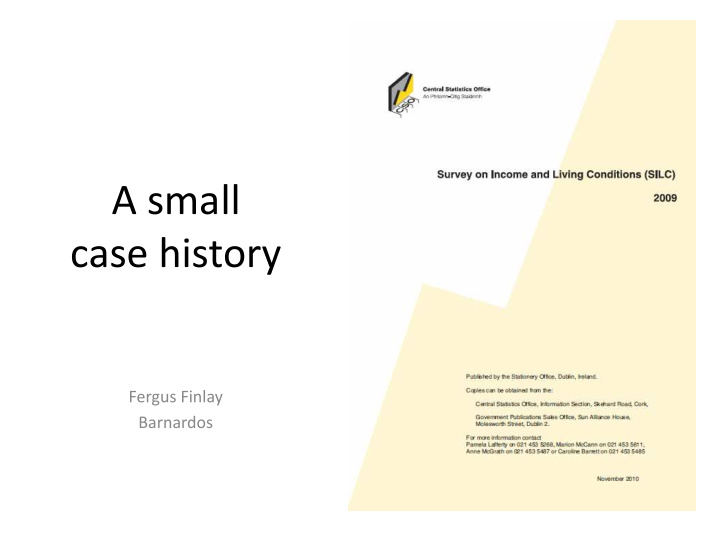



A small case history Fergus Finlay Barnardos
The basic facts • Children (aged 0-17) remained the most exposed age group with a consistent poverty rate of 8.7% in 2009, up from the 6.3% recorded in 2008. (That’s an increase of almost a half in one year.) This compares with a consistent poverty rate of 1.3% among persons aged 65-74 and just 0.9% among persons aged 75 or over in 2009. Almost 17% of people living in lone parent households • were in consistent poverty in 2009. (That’s children too.) From a household composition perspective lone parent households remained the household type with the highest consistent poverty rate. There was no significant change in their rate between 2008 and 2009.
Eleven Deprivation Indicators Without heating at some stage in the last year due to lack of money • Unable to afford a morning, afternoon or evening out in the last • fortnight Unable to afford two pairs of strong shoes • Unable to afford a roast once a week • Unable to afford a meal with meat, chicken or fish every second day • (that means not enough protein in the diet) Unable to afford new (not second-hand) clothes • Unable to afford a warm waterproof coat • Unable to afford to keep the home adequately warm • Unable to afford to replace any worn out furniture • Unable to afford to have family or friends for a drink or meal once a • month Unable to afford to buy presents for family or friends at least once a • year
Hard to make a story out of statistics Children (aged 0-17) were the most likely Individuals in lone parent households • • age group of those at risk of poverty to reported the highest rates of deprivation experience deprivation, with 46.7% experiencing two or more items of experiencing two or more items of deprivation at 44.1%. deprivation (that’s half of them), a rise of Children (aged 0-17) reported higher • 11.9 percentage points on the rate levels of deprivation (36.8%) than any reported in 2008 (34.8%). other age group. Over 23% of children Children's rates (46.7%) compared with a reported to have experienced two or • rate of 11.7% for people aged 65 and over more items of enforced deprivation in who were at risk of poverty in 2009. 2009 which is an increase from 18.1% in 2008. The most notable change in the year for • people at risk of poverty was the increase Almost 31% of people with a third level • in the number experiencing two or more degree or above had an equivalised items of deprivation, rising from 29.3% in disposable income of more than €740.49 2008 to 38.8% in 2009. in 2009. 62.9% of individuals in lone parent More than 63% of people with a primary • • families reported having experienced at education or below had an equivalised least one form of deprivation in 2009. disposable income of less than €335.49 per week.
Government reaction • Taoiseach – nothing • Finance – nothing • Health and Children – nothing • Minister for Children – nothing • Social Protection – “Ó Cuív shock at scaremonger tactics by Social Justice Ireland”
The coverage Irish Times • – Almost a quarter of households in arrears on bills – Household incomes down over 6% The Star - More People live in poverty • The Sun - 10% had to borrow • The Irish Independent - Nothing • The Irish Examiner - O Cuiv accuses welfare groups of 'scare tactics' •
The consequences • Tomorrow’s Budget – Child Benefit – Lone Parents – Mininum wage – Dependency rates • Next year’s EU-SILC figures? • If the economics of childhood aren’t covered, aren’t children more likely to be the “victims of recovery”?
Recommend
More recommend